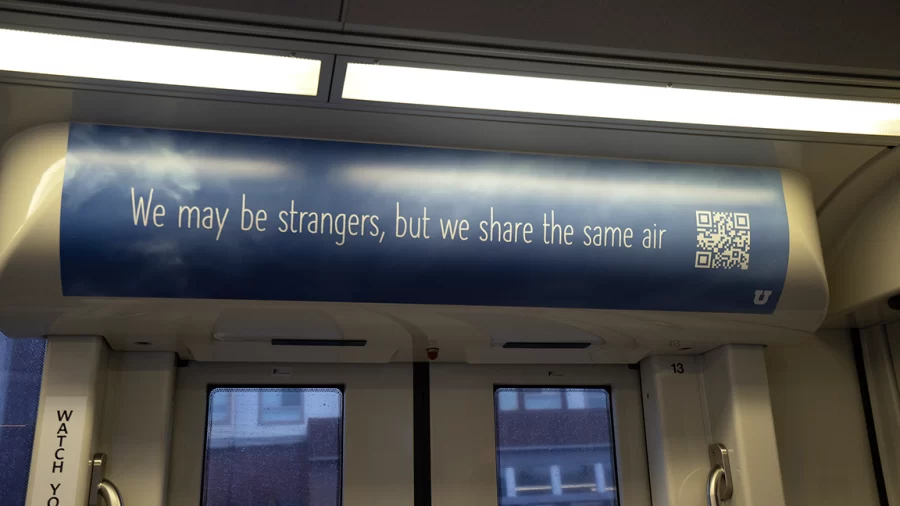‘In Search of Blue Sky’ Brings Attention to Salt Lake Air Quality Data
(Photo via the “In Search of Blue Sky” photo gallery)
January 18, 2023
You may have seen the mysterious signs that have shown up on our public transportation buses and the TRAX all throughout Salt Lake Valley. The signs are not present for the aesthetic, but rather have a special meaning. Take a look at the latest art project that makes a statement and acknowledges the importance of clean and healthy air.
I had the pleasure to sit and chat with U professor and artist Wendy Wischer. Wischer is one of the three masterminds behind “In Search of Blue Sky.” Wischer worked alongside John Lin, a professor in the Department of Atmospheric Sciences at the U, and Lindsey Webb, a U student pursuing a doctorate in creative writing, to create the public artwork.
Knowing such little information of the installation, I asked Wischer if she could go into detail on what “In Search of Blue Sky” is and how it works. Wisher explained that several years ago the atmospheric lab had put sensors on top of the TRAX cars and buses to collect real live data on Salt Lake’s air quality.
“We had received a grant that was charged with receiving data from the Wasatch Environmental Observatory,” she said. “It had to be a collaboration with at least two faculty members and a student from all different colleges.”
Wischer, Lin and Webb wanted to bring more public awareness to the website that collects real live data on the air quality around Salt Lake Valley with the art installation.
“We’re using signage on the [UTA] buses and outside the buses, as well as signs inside the TRAX,” Wischer said. “[The text on the signage is] intended to be poetic and to spark curiosity and conversations around air quality. We know that providing data doesn’t move people, so we were hoping that these poetic phrases might inspire people to go to the website.”
Signs of simple but mesmerizing phrases like “We may be strangers, but we share the same air” and “Some skies are bluer than others” not only capture your attention, but also thank those who take public transportation and acknowledges riders for their personal contributions on the journey for clean and healthy air.
‘In Search of Blue Sky’
On Aug. 6, 2021, Salt Lake City was reported to have some of the worst air quality in the world, according to Fox13. “In Search of Blue Sky” makes you ponder and question the health of the environment as well as our personal health as a community.
When asked what inspired the team to create the project, Wischer explained that Lin had come to her a few years ago and asked if there was something she could do to bring attention to the sensors on the TRAX and city buses. It had taken Wischer a few years to create the idea but once the opportunity of the grant came along, she collaborated with Lin and Webb to bring their project to life.
The impact of “In Search of Blue Sky” demands a potent question: If the project only had the scientific data without the art aspect, would it receive the same recognition as it does now?
“I want to try to help people connect with their environment,” Wischer said. “I often refer to that I’m translating data into personal meaning. We know that just providing data doesn’t move people. Scientific data is supposed to be objective, so art can really pull in emotions. And emotions are what move people. I really believe it’s the combination of the data with some of the artistic aspects that can try to create personal meaning to people on why this data is important and what it should mean to them.”
How to Get Involved
As mentioned previously, the project is in collaboration with the WEO to collect live data on air quality throughout the city. The project and website are a perfect resource to gain a better understanding of the atmosphere and air quality that we live in.
I asked Wischer for advice on how people can get involved with improving our environment.
“There are many organizations around the valley that are addressing a huge variety of environmental issues,” she said. “I would say first to find what they care about the most.”
Wildlife Rehabilitation Center of Northern Utah and Friends of Great Salt Lake are awesome organizations that tackle the issues of environmental change. Finding an organization you feel most connected to is a great start to making a change for not only our planet and the animals surrounding us, but for the health of our future.
Take a look at the “In Search of Blue Sky” website for more information.








